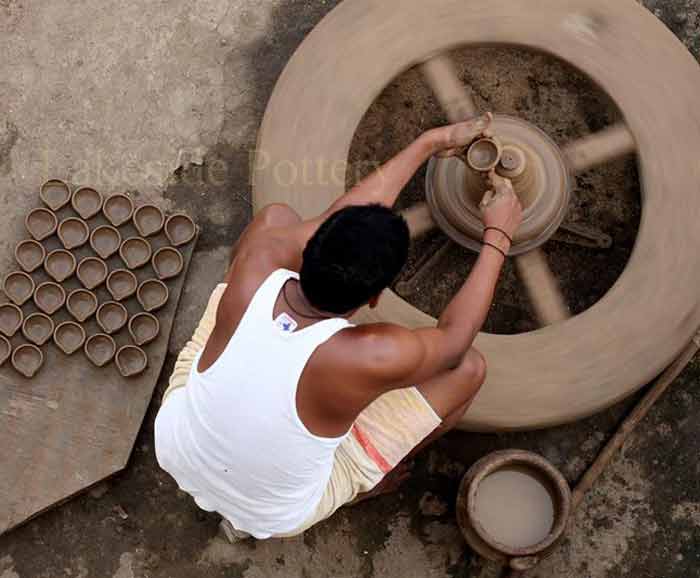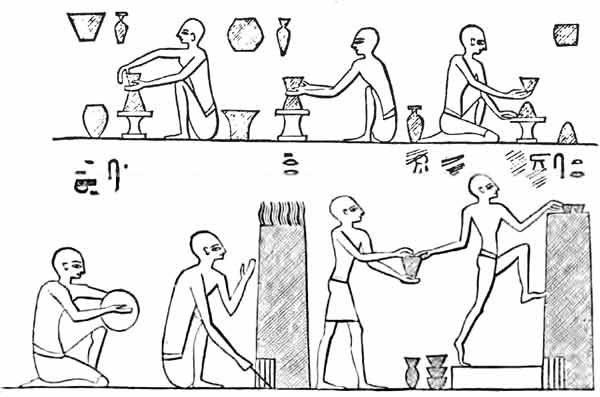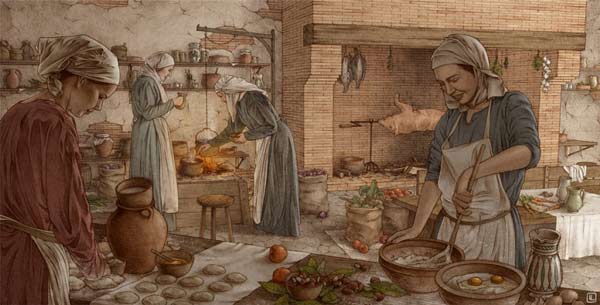|

Indian Potter, Hyderabad, Andhra Pradesh, Southern India.
|
Pottery is our oldest handicraft. In prehistoric times, most likely water was carried in woven baskets lined with river clay. After the water was poured out of the container the layer of clay dried. The loss of moisture caused the shape to shrink and separate from the sides of the basket. When the clay, now shaped like a pot, was removed, and dried in the sun on hot sand, it retained the basket pattern. Early men and women then discovered that they could harden the molded pottery in hot ashes and make sturdy containers to transport and store food. From these would have been extended the pots formed by hand and decorated with crude tools.
|
From a very early date in history, some say at least 400 B. C., earthenware pottery was produced on a mass scale by a potter's wheel in many parts of the world.
|
The Egyptians made kilns to place their clay pots in for firing. The kiln was lined with a kind of insulation brick that was made from a mixture of straw and clay which had been dried in the sun. Later, the ancient Egyptians used a finer clay with a high quartz content for their delicate pottery. They rubbed the pieces with a smooth stone to give the a dull sheen or coated them with a fine layer of another color of clay.
Further experimentation lead the Egyptians to coat their clay objects with a bluish-green substance to make them non-porous. This was a glaze composed of quartz, soda, and a mineral containing copper which when fired covered the clay bowls and vases with a glass-like surface.
|
 |
|
|
Ancient Greek vases are highly valued for form and decoration. The graceful lines an perfect balance speak to our desire for beauty. The pottery was decorated with pictures of the daily lives of the people and stories of their gods, goddesses and heroes. On the red figure vases the background was painted black and the figures were left the natural red color of the clay. The color was reversed on the black-figured vases
|
|
In medieval times sand was mixed with clay to make cooking pots strong enough to be placed over an open fire. Today, for the same reason, casseroles used for baking are made from clay mixed with grog which is a ground-up fired pottery. The openness of grog clay allows water to evaporate more evenly as it dries and prevents cracking and warping during the firing. Grog clay eases the problem of heat expansion which can cause large thick pieces of pottery or sculpture to blow up in the kiln.
|
 |
|
|
Around the middle of the thirteenth century German potters started to produce stoneware. This pottery was made form finer clays and fired at a higher temperature than earthenware. Stoneware was tan or gray in color, strong and naturally non-porous.
|
Japanese Gold Kintsugi Repair
History and Metaphor - More

|
Light, transparent porcelain was first produced in China. Porcelain was made from a very plastic and pure clay called kaolin mixed with felspar. The colorful decoration of the porcelain was accomplished by firing each color individually after it was applied. These delicate china dishes and figurines were in demand all over Europe. In their efforts to unravel the secret of the composition of the Chinese porcelain, European and other Asian potters developed many variations in their glazing techniques.
Rakuware is another type of pottery of special interest. The crackled glaze of Raku originated in Japan where tea bowls were modeled by hand from a very coarse clay (Hanson, 1970).
Late in the sixteenth century, a trade route through Manila, brought pottery from China to Acapulco to Vera Cruz, Mexico to Europe.
|
|
|